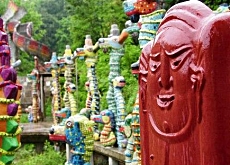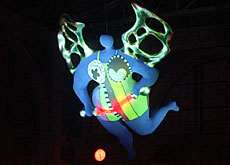Weber invites public into his imagination

If you have visited Gaudí's Park Güell in Barcelona and the Hundertwasser House in Vienna, then Bruno Weber's Sculpture Park near Zurich should be your next stop.
But while my taxi driver didn’t hesitate to drive to the park, he admitted he wouldn’t want to be surrounded by all of the surreal, mythical creatures after dark.
Unlike Gaudí and Hundertwasser, who died in 1926 and 2000 respectively, Bruno Weber is a living legend and is currently halfway through the most monumental of his larger-than-life works: his “Water Garden”.
The entrance to the park, situated on the outskirts of Dietikon, a town not far from Zurich, looks harmless enough: birds of paradise are perched on a wrought iron gate that swings open like wings onto the grounds.
A little further inside, two flying dogs, 105 metres in length, are locked in combat forming a semi-circle around a grassy pit. Weber climbs the steps to the top of the four-storey-high creatures’ backs – and eventually into their jaws.
From this vantage point, the 75-year-old sculptor describes what is yet to come: three stylised caterpillars even larger than the dogs will join heads at the centre of a raised stage. The pit in the middle will be filled with water.
“I don’t know if it’ll ever be finished,” Weber told swissinfo. “I’m doing my best, but one never knows since I can’t say how long I’ll live.”
The artist says the Water Garden will cost about SFr5 million ($4.05 million) in total. He adds that he and his wife Mariann Godon are able to continue the work thanks to a SFr600,000 cantonal grant secured a few months ago. The couple are confident that if they cannot finish the job themselves, the work will be taken over by their twin daughters – both artists in their own right – or other “creative individuals”.
Weber says the completed park will provide a stage for “artists of all stripes” excited about the idea of performing in such a unique space. “I’m looking forward to the first performance,” he said.
Biomorphic creatures
The entire grounds cover 20,000 square metres and are populated by biomorphic garden and forest sculptures inspired by eastern mythology, European fables and, more importantly, Weber’s own imagination.
“I grew up in a beautiful Baroque house here in Dietikon which had many mysterious rooms, and many had never really been explored,” he remembers. “This experience made quite an impression on me.”
He began painting at the tender age of 11, inspired by his home and the artist who lived next door. He attended art school in Zurich between 1947 and 1949 and dedicated his life to painting up until 1969 when he made his first sculpture for the park.
The profusion of sinister, comic and melancholic characters that have come into being over the years since then give visitors to Weber’s world a first-hand experience of what he means when he says function is as important as form.
Pelicans
The works are benches to sit on or arches to pass under. Concrete tables are disguised as pelicans and the antlers of upright deer are fitted with lamps to light the way.
Fat amphibious creatures spout water into a pond bridged by a serpent. Upon closer inspection, the snake is a children’s slide. The call of a real peacock blurs the already fuzzy line dividing Weber’s real and fantasy worlds.
But the artist himself makes no separation. He and Godon live on the property in a self-built house that would look more at home in Tolkien’s Middle-earth than a nondescript suburb of Zurich.
Its facade is a mosaic of Gothic gargoyles, nymph-like pillars and carved banisters topped by a 25-metre-high tower.
Once inside, visitors immediately enter the dining room. The floor is a mosaic labyrinth, each tile painstakingly laid by Godon over an eight-month period.
The ceiling is supported by the wings of imaginary beings and the fireplace is also creature-shaped, with heat exhaling from its nostrils.
When I finally summon up the courage to ask the artist to define reality, he refuses to take the bait.
swissinfo, Dale Bechtel in Dietikon
Bruno Weber’s sculpture park is open to the public every Saturday from 1pm to 5pm between April and the end of October.
Entrance costs SFr10.
Guided tours for groups up to 15 people can be arranged with advance notice at any time of the year. Cost is SFr200 per group.
Dietikon is about 15 minutes from Zurich by train.
The artist was born in 1931.
When he was only 12, Weber had the honour of showing his first oil painting to the well-known Swiss artist, Max Gubler.
Gubler, along with his brother Ernst (sculptor), later became one of Weber’s teachers at art school in Zurich.
Under pressure from his family, he became a graphic artist with the Swiss publisher, Orell Fuessli.
He eventually devoted 25 years exclusively to painting, developing his own style, which he named “fantastic realism”.
He started his sculptural work on the park grounds in Dietikon in the 1960s with the construction of his house.

In compliance with the JTI standards
More: SWI swissinfo.ch certified by the Journalism Trust Initiative











You can find an overview of ongoing debates with our journalists here . Please join us!
If you want to start a conversation about a topic raised in this article or want to report factual errors, email us at english@swissinfo.ch.